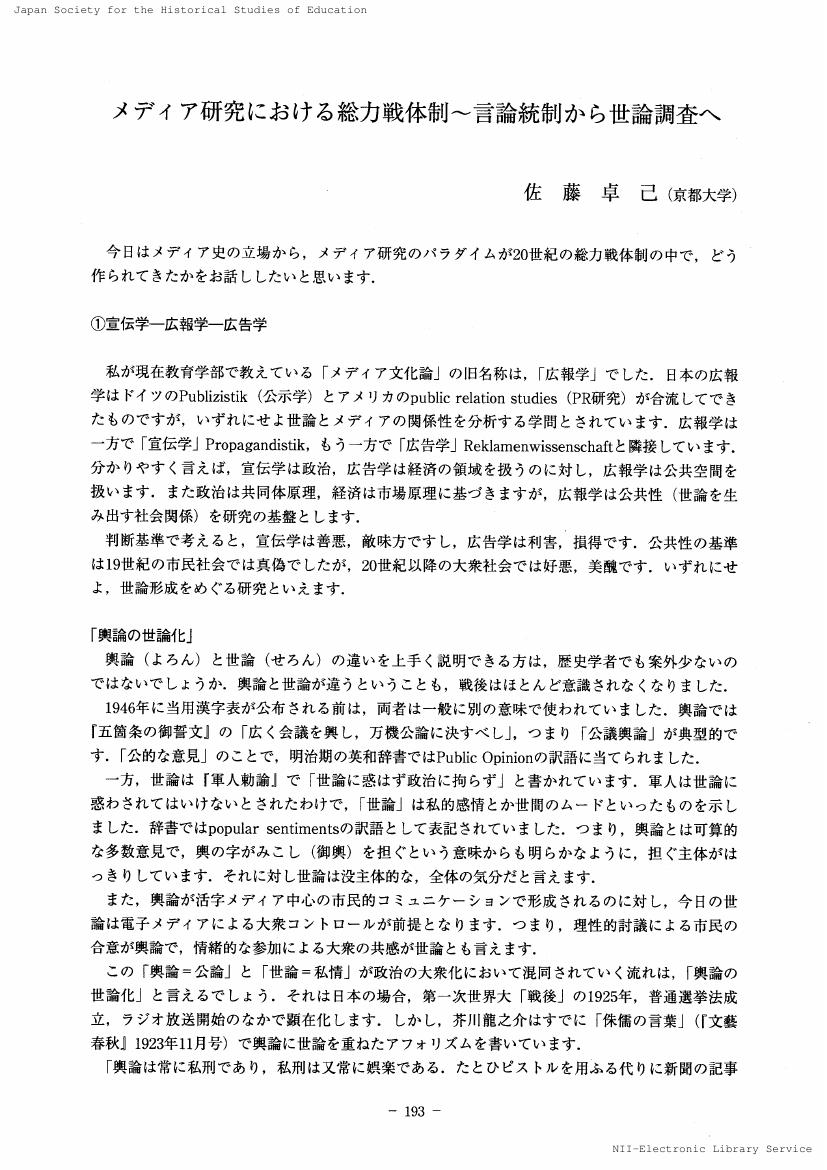73 0 0 0 OA 教育将校・鈴木庫三の軌跡 : 日本大学助手から情報局情報官へ
- 著者
- 佐藤 卓己
- 出版者
- 日本大学教育学会
- 雑誌
- 教育學雑誌 (ISSN:02884038)
- 巻号頁・発行日
- vol.43, pp.1-18, 2008-03-25 (Released:2017-01-04)
10 0 0 0 OA メディアが創った「終戦」記念日 : VJ-Dayから8・15へ
- 著者
- 佐藤 卓己
- 出版者
- 国際日本文化研究センター
- 雑誌
- Historical Consciousness, Historiography, and Modern Japanese Values
- 巻号頁・発行日
- pp.65-73, 2006-11-30
Historical Consciousness, Historiography, and Modern Japanese Values, 2002年10月末-11月, カナダ, アルバータ州バンフ
8 0 0 0 OA 大衆の国民化,なお消え去らぬ弾丸効果論 メディア史の視点から
- 著者
- 佐藤 卓己
- 出版者
- 日本メディア学会
- 雑誌
- マス・コミュニケーション研究 (ISSN:13411306)
- 巻号頁・発行日
- vol.97, pp.47-63, 2020-07-31 (Released:2020-09-26)
- 参考文献数
- 28
In the works of the author, Takumi Sato, who has been changed from aGerman modern history scholar to a media historian, the concept of “Mass” hascrucial importance. This paper examines the role of the active masses who supportedthe Nazi regime, collating the arguments of George L. Mosse, Thenationalization of the masses; political symbolism and mass movements in Germanyfrom the Napoleonic wars through the Third Reich (1975=1994) andTakumi Sato, The Fascist Public Sphere; Media Studies of Total War (2018).The Nazi regime did not succeed due to manipulation of the masses throughpropaganda, but was instead supported by voluntary movements by the massesfor national consensus building. From this viewpoint, the framework of mediastudies on the fascist movements should be changed from “Nazi propaganda” to“Nazi public relations.” As an outstanding analysis during the time of Nazi propaganda,Serge Chakotin, The Rape of the Masses; The Psychology of TotalitarianPolitical Propaganda (1939) can be reread. In recent years, the book hasbeen republished and translated around the world, including an edition in Japanese(2019). What does the revival of this book mean? It shows that the bulleteffect theory functions as an excuse for the active masses who take part in thepolitical public sphere. Theoretically, the bullet effect theory was denied in the1950s by the limited effect theory. However, it is thought that its popularity hasnot abated because of the support by the nationalized masses in the informationsociety.
4 0 0 0 OA ソフト・パワー構築に向けたメディア文化政策の国際比較研究
- 著者
- 佐藤 卓己 渡辺 靖 植村 和秀 柴内 康文 福間 良明 青木 貞茂 本田 毅彦 赤上 裕幸 長崎 励朗 白戸 健一郎 松永 智子
- 出版者
- 京都大学
- 雑誌
- 基盤研究(B)
- 巻号頁・発行日
- 2009
情報化の先進諸国におけるメディア文化政策の展開を地域別(時系列的)、メディア別(地域横断的)に比較検討し、国民統合的な「文化政策」と情報拡散的な「メディア政策」を明確に区分する必要性を明らかにした。その上で、ソフト・パワーとしては両者を組み合わせた「メディア文化政策」の重要性が明らかになった。佐藤卓己・柴内康文・渡辺靖編『ソフトパワーとしてのメディア文化政策』を新曜社より2012年度中に上梓する。
3 0 0 0 OA <<メディア史>>の成立 : 歴史学と社会学の間
- 著者
- 佐藤 卓己 Takumi Sato
- 雑誌
- 社会学部紀要 (ISSN:04529456)
- 巻号頁・発行日
- no.別冊, pp.1-26, 2011-03-15
- 著者
- 佐藤 卓己
- 出版者
- 関西学院大学社会学部研究会
- 雑誌
- 関西学院大学社会学部紀要 (ISSN:04529456)
- 巻号頁・発行日
- pp.1-26, 2011-03
3 0 0 0 近代日本の政治エリート輩出における「メディア経験」の総合的研究
- 著者
- 佐藤 卓己
- 出版者
- 教育史学会
- 雑誌
- 日本の教育史学 : 教育史学会紀要 (ISSN:03868982)
- 巻号頁・発行日
- vol.49, pp.193-198, 2006-10-01
3 0 0 0 OA 「NHK青年の主張」における青年文化のメディア社会学
3 0 0 0 OA 20世紀東アジアにおける視聴覚メディアの相互連関
2 0 0 0 OA 書物がメディアになるとき : メディア史からの視点(<特集>電子ブックと出版)
- 著者
- 佐藤 卓己
- 出版者
- 一般社団法人 情報科学技術協会
- 雑誌
- 情報の科学と技術 (ISSN:09133801)
- 巻号頁・発行日
- vol.62, no.6, pp.230-235, 2012-06-01 (Released:2017-04-18)
- 参考文献数
- 11
デジタル・テクストとして物理的存在を欠いた電子ブックの普及は,「書物」の再定義をせまっている。しかし,電子ブック登場以前から,書物はすでに大きな変容を遂げてきている。本稿では比較メディア論の視点から,書物の変容を1920年代のラジオ放送開始,1930年代のペーパーバック革命において検討した。それは「書物のラジオ化/雑誌化」,すなわち「書物の広告媒体(メディア)化」の系譜である。こうした「書物のメディア化」の最終段階として,広告料収入で運営されるメディア企業,Googleによるライブラリープロジェクトが登場する。ウェブ2.0時代のコミュニケーション状況において「書物のデジタル化」がもたらす問題点を整理した上で,電子ブックを既存の書物のリテラシーに接合する必要性を指摘した。
2 0 0 0 「報道の自由度ランキング」への違和感
- 著者
- 佐藤 卓己
- 出版者
- 阪急コミュニケーションズ
- 雑誌
- アステイオン
- 巻号頁・発行日
- no.85, pp.162-177, 2016
2 0 0 0 青年の主張 : まなざしのメディア史
2 0 0 0 図書館とホロコースト否定文献 : ウェイン・A.ウィーガンド編(川崎良孝・薬師院はるみ訳)『「図書館の権利宣言」を論じる』(京都大学図書館情報学研究会発行,日本図書館協会発売,2000年)を読んで
- 著者
- 佐藤 卓己
- 出版者
- 日本図書館研究会
- 雑誌
- 図書館界 (ISSN:00409669)
- 巻号頁・発行日
- vol.52, no.5, pp.279-281, 2001-01-01
- 著者
- 佐藤 卓己
- 出版者
- 社団法人情報科学技術協会
- 雑誌
- 情報の科学と技術 (ISSN:09133801)
- 巻号頁・発行日
- vol.62, no.6, pp.230-235, 2012-06-01
デジタル・テクストとして物理的存在を欠いた電子ブックの普及は,「書物」の再定義をせまっている。しかし,電子ブック登場以前から,書物はすでに大きな変容を遂げてきている。本稿では比較メディア論の視点から,書物の変容を1920年代のラジオ放送開始,1930年代のペーパーバック革命において検討した。それは「書物のラジオ化/雑誌化」,すなわち「書物の広告媒体(メディア)化」の系譜である。こうした「書物のメディア化」の最終段階として,広告料収入で運営されるメディア企業,Googleによるライブラリープロジェクトが登場する。ウェブ2.0時代のコミュニケーション状況において「書物のデジタル化」がもたらす問題点を整理した上で,電子ブックを既存の書物のリテラシーに接合する必要性を指摘した。
2 0 0 0 OA 放送メディア教育の成立と展開
- 著者
- 佐藤 卓己
- 出版者
- 教育史学会
- 雑誌
- 日本の教育史学 (ISSN:03868982)
- 巻号頁・発行日
- vol.49, pp.193-198, 2006-10-01 (Released:2017-06-01)
1 0 0 0 テレビ的教養 : 一億総博知化への系譜
1 0 0 0 OA 近代日本における流言効果のメディア史的研究
流言蜚語がメディアを通じて世論形成に与えた影響に関する日本現代史を体系的に考察した。その成果が『考える人』に連載した「メディア流言の時代」全8回である。補論を加えて2017年に単行本化する予定である。また、メディア流言史の視点から2014年の「朝日新聞誤報問題」についても、論点整理を行った。「誤報事件の古層」(『図書』2014年12月号・岩波書店)や「誤報のパラダイム転換」(『Journalism』2015年3月号・朝日新聞社)である。理論的な総括は、「デジタル社会における〝歴史〟の効用」『岩波講座 現代 1―現代の現代性』(岩波書店・2015年)で行った。
1 0 0 0 広報・広告・プロパガンダ
- 著者
- 津金澤聡廣 佐藤卓己責任編集
- 出版者
- ミネルヴァ書房
- 巻号頁・発行日
- 2003





